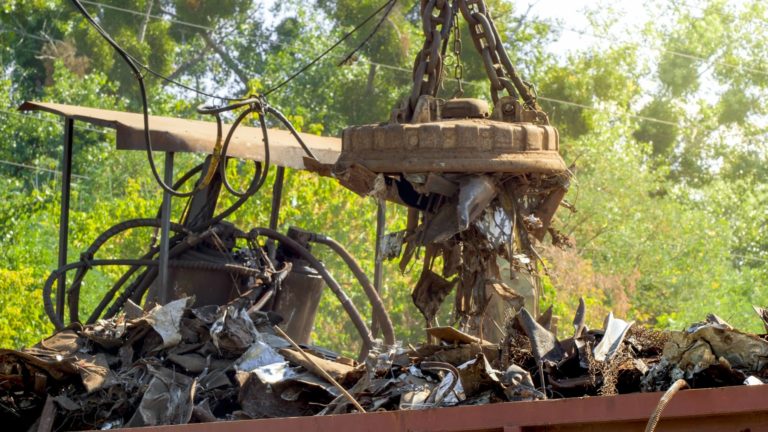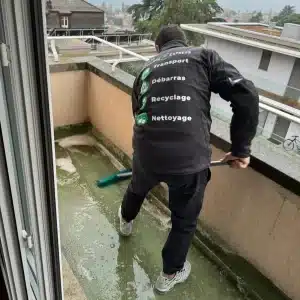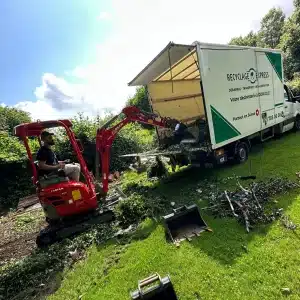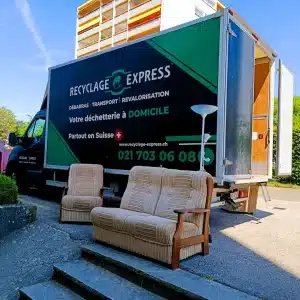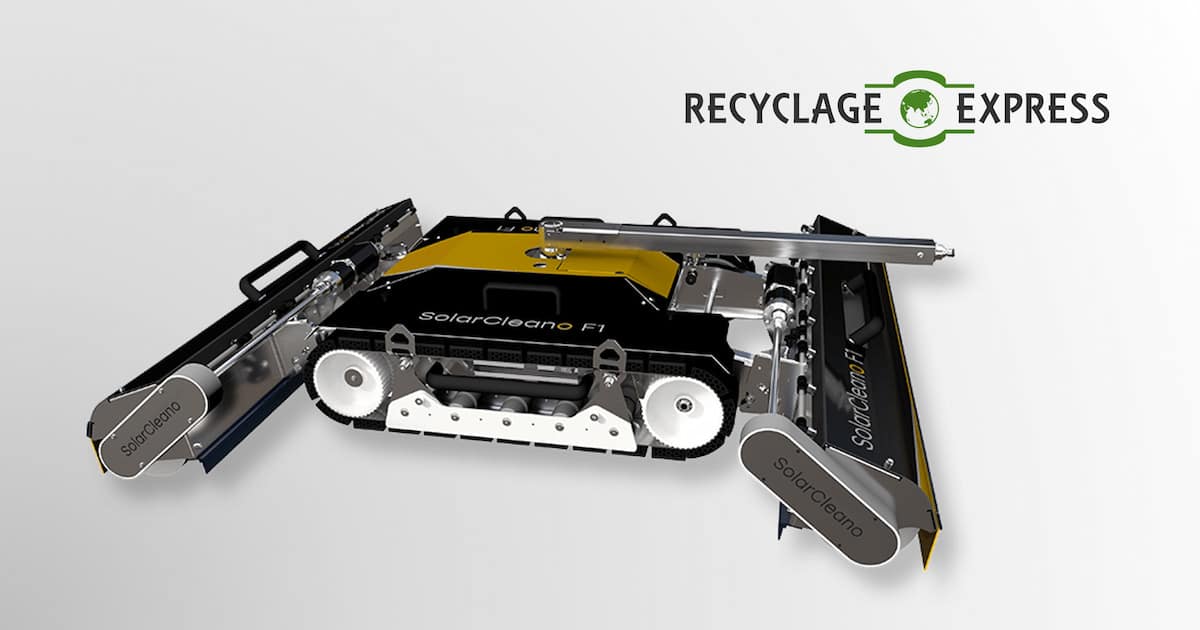
Solar energy is gaining ground in Switzerland, where the cleanliness of solar panels plays a crucial role in their performance. Regular cleaning is essential to maintain the efficiency of the panels. Two methods stand out: manual cleaning, which depends on human effort, and robotic cleaning, facilitated by devices such as the SolarCleano F1.
Manual cleaning uses specific tools and requires direct intervention, while robotic cleaning, with machines such as the SolarCleano F1 Or iSolar of KÄRCHER offers an automatic solution. Each method has its advantages and limitations. This article examines both approaches to help you choose the best option for your installations.
Why is solar panel cleaning essential?
Cleaning your solar panels isn't just about aesthetics; it's crucial to their performance. When panels get dirty, their ability to produce energy decreases.
Effects of dirt on performance
Dirt, dust, leaves, or even bird droppings can obscure the surface of your solar panels, reducing their ability to capture sunlight. Even a thin layer of dust can cause a noticeable drop in efficiency.
In fact, fouling can reduce the solar panel efficiency up to 25%. A thin layer of dirt can also reduce this 10% yield.
These efficiency losses mean that uncleaned solar panels produce less electricity, which directly impacts your energy bill and the profitability of your solar investment.
Consequences of insufficient maintenance
Poor maintenance of solar panels can have serious long-term consequences. The build-up of dirt and debris not only reduces energy efficiency in the short term; it can also lead to permanent damage to solar panels, affecting their durability and long-term operation.
Many solar panel manufacturers make warranty coverage conditional on regular maintenance. Poor maintenance can void the warranty, leaving owners unprotected in the event of failure or reduced performance due to premature wear.
In conclusion, regular maintenance of solar panels is essential to prevent damage, extend the life of the installation and ensure optimal operation. Ignoring necessary maintenance can lead to higher costs in the long term, both in terms of repair and replacement as well as energy production losses.
Manual cleaning of solar panels
Process and tools
Manual cleaning of solar panels is broken down into structured steps for maximum efficiency:
- Initial inspection : Identification of dirty or damaged areas on the panels.
- Preparing the tools : Assembly of necessary equipment, such as soft brushes, squeegees, and microfiber cloths.
- Implementation of security measures : Establishment of protocols to ensure the safety of technicians, particularly for high panels.
- Humidification : Application of demineralized water on the panels to facilitate the removal of impurities.
- Cleaning : Gentle rubbing of the panels with suitable tools to remove dirt without causing damage.
- Rinsing : Remove dirt and cleaner residue with clean water.
- Drying : Allow panels to dry naturally or wipe dry to avoid water marks.
- Inspection and final verification : Control of the cleanliness of the panels and verification of their operational performance.
This methodical process helps maintain the efficiency of solar panels and contributes to their longevity.
Tools used for manual cleaning include soft brushes, squeegees, and microfiber cloths, often used with demineralized or filtered water to prevent limescale deposits. Specific, non-abrasive and environmentally friendly cleaning solutions are also used to remove dirt without damaging the panel surfaces.
Innovations in manual cleaning tools include telescopic poles that allow panels to be reached at height without the need for scaffolding, reducing the risk of falls and injury.
Advantages and Disadvantages of Manual Cleaning on Solar Panels
Benefits
- Precision : Manual cleaning allows you to specifically target dirty or clogged areas, ensuring a complete clean.
- Risk minimization : When done correctly, manual cleaning is less likely to cause damage to panels, compared to some automatic methods which can be too abrasive.
- Flexibility : This method adapts to different types and configurations of solar panels, offering a customized solution according to the specific needs of the installation.
Disadvantages
- Labor requirement : Manual cleaning is often more time-consuming and labor-intensive, requiring significant labor, especially for large installations.
- Risk to personnel : Cleaning panels installed at height can pose a fall hazard for workers.
- Frequency of cleaning : As the process is more time and labor intensive, manual cleaning may not be performed as frequently as necessary, which can lead to dirt build-up and affect panel performance.
In summary, manual cleaning of solar panels offers precise control and is tailored to the specifics of each installation, but it is more labor intensive and presents some risks to personnel. The choice between manual cleaning and other methods will depend on the specific conditions of each site, available resources and safety considerations.
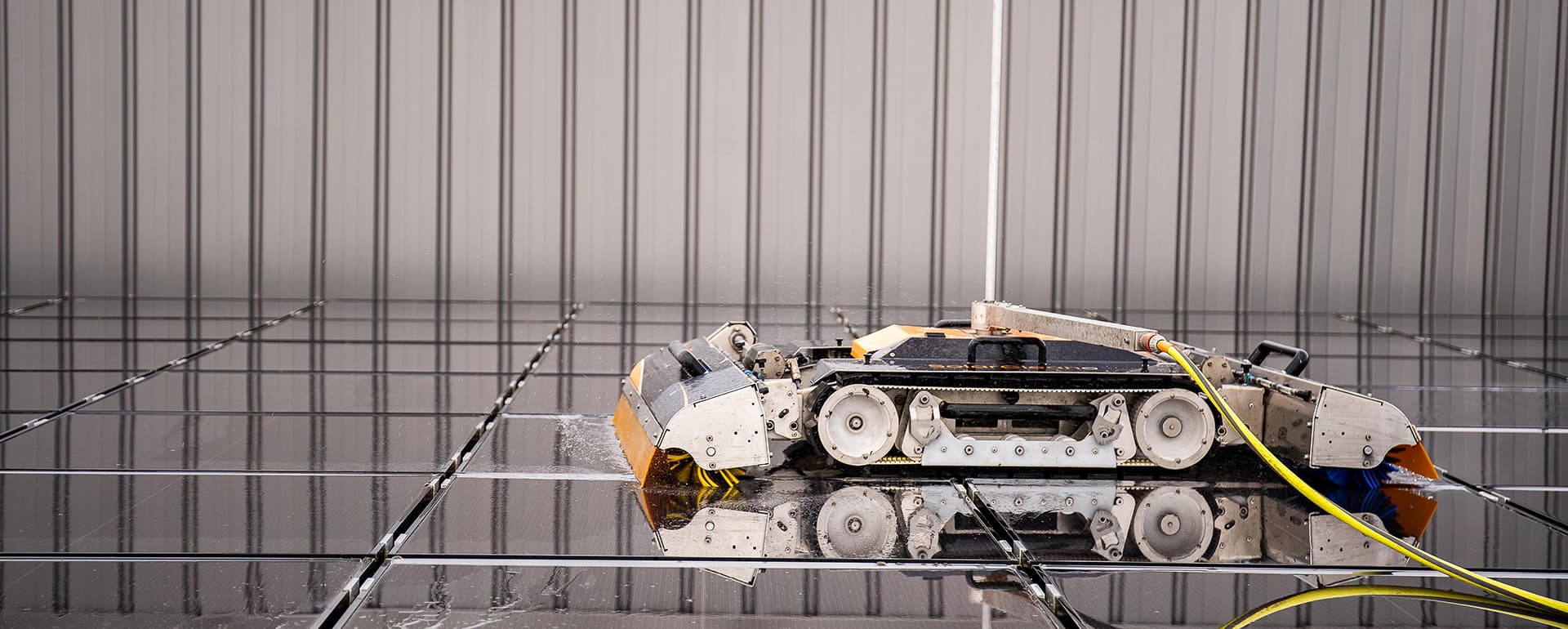
Robotic cleaning of solar panels with the SolarCleano F1
Description of the SolarCleano F1
THE SolarCleano F1 is a robot designed for automatic cleaning of solar panels. It adapts to standard garden hoses of 13-15 mm diameter, operating at a water pressure between 2.0 and 8.0 bars. This allows efficient cleaning, either with water or dry, depending on the specific needs of the installation.
This robot is equipped with helical brushes, available in lengths of 1.1m, 1.2m, and 2.2m, with two types of bristles suitable for both wet and dry cleaning. Its system is certified not to cause microcracks after cleaning, thus guaranteeing the safety of the treated solar panels. With a fast cleaning capacity, it is indicated as the fastest on the market, capable of cleaning up to 1,600 m² per hour.
Benefits of automation with the SolarCleano F1
- Regularity and efficiency : The SolarCleano F1 ensures regular cleaning, which is crucial for maintaining the energy efficiency of solar panels. Its ability to clean large areas quickly helps reduce the downtime of solar panels and increase their energy production.
- Cleaning accuracy : Thanks to its advanced technology, the SolarCleano F1 can precisely target dirty areas, ensuring deep cleaning without damaging the panels. The different sizes and types of brushes allow adjustment according to the nature of the dirt and the configuration of the solar installation.
- Operational security : Using this robot reduces the risks associated with manual cleaning, including falls and accidents. Operated remotely, it allows safe intervention, particularly in difficult or dangerous conditions.
- Environmental impact : Robotic cleaning with the SolarCleano F1 also contributes to a reduced environmental impact. By optimizing water usage and avoiding the use of harmful chemicals, the robot supports a more sustainable approach to solar panel cleaning.
SolarCleano F1 represents an advanced solution for cleaning solar panels, combining speed, efficiency, and safety, while supporting an environmentally friendly approach.
Limitations of use of SolarCleano F1
Using the SolarCleano F1 robot for cleaning solar panels has several advantages, but there are situations where its use may be limited or less appropriate:
- High initial cost : The initial investment in a cleaning robot like the SolarCleano F1 can be substantial. For smaller installations or for homeowners on a budget, the cost of acquiring the robot can be a deterrent.
- Technological complexity : Deploying and managing the SolarCleano F1 requires some technical expertise. Users must be trained to operate the robot effectively, which can be a challenge for facilities managed by less tech-savvy individuals.
- Access limitations : Although the robot is designed to be adaptable, there may be solar panel configurations or environments (such as very rough terrain or extremely confined spaces) where the robot cannot access or operate effectively.
- Dependence on weather and environmental conditions : The robot may be less effective in certain extreme weather conditions, such as heavy rain, high winds, or freezing temperatures, which may affect its performance or ability to clean properly.
- Maintenance and repair : Like any complex machine, the SolarCleano F1 may require regular maintenance and sometimes repairs. If specific components fail or wear out, this can lead to downtime and additional costs.
- Effectiveness on different types of dirt : Although the robot is equipped with brushes suitable for different types of dirt, it may be less effective against very adherent or encrusted dirt that requires special or manual treatments.
- Energy use for operation : The robot's operation requires energy, usually provided by batteries. In situations where energy saving is a priority, or in places where access to electricity is limited, this could be a disadvantage.
SolarCleano F1 offers significant advantages in terms of efficiency and safety for cleaning solar panels. However, its use could be limited by factors such as cost, accessibility, technological complexity, environmental conditions, and maintenance needs.
Additional Resources
For a deeper understanding and to visualize the SolarCleano F1 in action, check out these resources:
YOUTUBE VIDEOS 👇
🔗 SolarCleano solar panel cleaning robot dry cleans in the Middle East
🔗 Cleaning floating solar installations with SolarCleano robots
Detailed Comparison: Manual vs Robotic Solar Panel Cleaning
To help you decide between manual and robotic solar panel cleaning, consider the criteria of time, cost, efficiency, safety, and durability.
| Criteria | Manual Cleaning | Robotic Cleaning |
| Time | Longer, depending on the number of operators | Faster, covers large areas quickly |
| Cost | Lower initial cost, but more expensive labor | Higher initial investment, lower operational costs |
| Efficiency | Depends on the skill of the operators | Consistent and high, thanks to advanced technology |
| Security | Risk of falling or injury | Lower physical risk, remote control |
| Sustainability | Uneven wear, depends on cleaning frequency | Uniform cleaning, can extend the life of panels |
Best apps for each method:
- Manual cleaning : Ideal for small installations or those with difficult access where robotic cleaning is not practical.
- Robotic cleaning : Preferable for large installations, where speed and reduced operational costs are priorities.
Choosing the Right Cleaning Method for Your Facility
To determine the most suitable cleaning method, consider:
- Installation type : Smaller or complex installations may benefit from manual cleaning, while large, uniform installations are ideal for robotic cleaning.
- Geographical context : Local environmental conditions, such as frequency of rainfall or presence of dust, influence the need for and frequency of cleaning.
- Budgetary considerations : Evaluate the potential ROI of robotic cleaning versus the long-term costs of manual cleaning.
In conclusion, the choice between manual and robotic cleaning depends on the specificities of each solar installation, environmental conditions, and financial and ecological objectives. A careful assessment of these factors will help determine the most appropriate solution, thus ensuring maximum efficiency and sustainability of photovoltaic installations.
Conclusion
In Switzerland, where solar energy is becoming increasingly predominant, optimal maintenance of solar panels through cleaning is essential to ensure their maximum performance. The energy efficiency and sustainability of solar installations largely depend on the cleanliness of the panels. Whether through manual or robotic cleaning, each method has specific advantages adapted to various needs and contexts.
The SolarCleano F1, with its ability to clean efficiently and without risk of damage, emerges as a cutting-edge technological solution for the maintenance of solar panels. Its performance in terms of coverage, water savings and respect for the environment marks a significant evolution in the field of cleaning photovoltaic installations.
To ensure the longevity and efficiency of your solar installations, opt for a cleaning solution that combines human expertise and technological innovation.
Contact Recyclage Express for a free quote and find out how our services, including the use of SolarCleano F1, can transform the maintenance of your solar panels. Whether you are an agricultural producer or a large industrial company, we have the right solutions to optimize the energy efficiency of your installation.
Maximize the efficiency of your solar panels with Express Recycling and ensure a cleaner, more sustainable energy future for your business or home.


